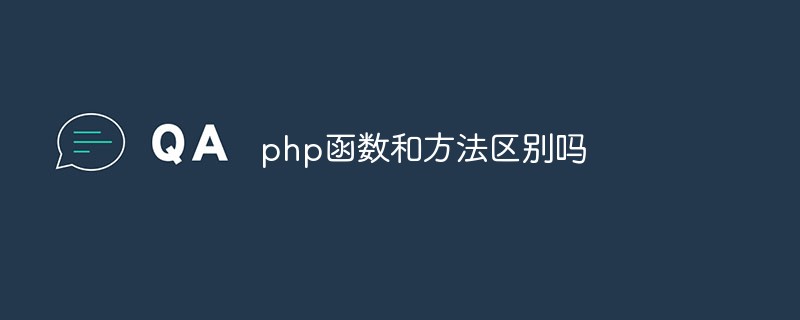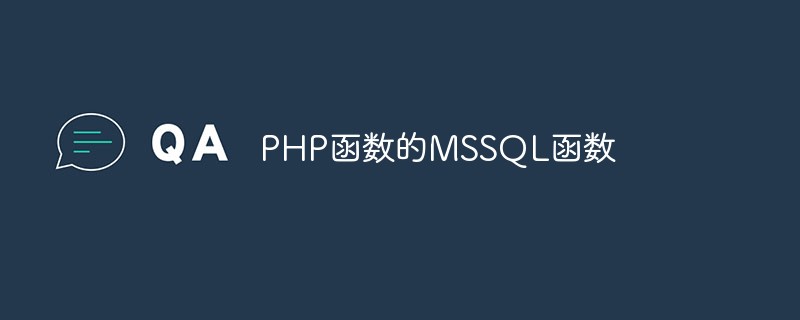PHP is a widely used server-side scripting language used to develop dynamic websites, web applications, and other Internet services. In the process of developing PHP applications, using functions can help simplify code, improve code reusability, and reduce development costs. This article will introduce the basic usage and advanced usage of PHP functions.
1. Basic usage of PHP functions
1. Define functions
In PHP, use the function keyword to define functions, for example:
function greet($name) {
echo "Hello, " . $name . "!";
}The above code defines a function called greet, which takes a parameter $name and outputs a greeting message on the screen. To call this function, you pass arguments to it, for example:
greet("John");This will output "Hello, John!" to the screen.
2. Function return value
Function can return a value, for example:
function add($a, $b) {
return $a + $b;
}
$result = add(2, 3);
echo $result; // 输出 5The above code defines a function named add, which takes two parameters $ a and $b, and return their sum. To call this function and get the return value, use something similar to the code above.
3. Function parameters
A function can have any number of parameters, for example:
function multiply($a, $b, $c=1) {
return $a * $b * $c;
}
$result = multiply(2, 3);
echo $result; // 输出 6
$result = multiply(2, 3, 4);
echo $result; // 输出 24The above code defines a function named multiply, which has two required Parameters $a and $b, and an optional parameter $c (default is 1). In the first example, $a imes b imes c$ will be calculated using the default value, while in the second example, the passed value will be used.
2. Advanced usage of PHP functions
1. Anonymous functions
In PHP 5.3 and later versions, anonymous functions can be used. An anonymous function is a function without a name, for example:
$greet = function($name) {
echo "Hello, " . $name . "!";
};
$greet("John"); // 输出“Hello, John!”The above code creates an anonymous function and assigns it to the variable $greet. This function can be called like a regular function.
2. Variable functions
In PHP, you can store function names in variables and call them as functions. For example:
function greet($name) {
echo "Hello, " . $name . "!";
}
$function_name = "greet";
$function_name("John"); // 输出“Hello, John!”The above code stores the function name in the variable $function_name and uses it as a function call. This technique helps to call functions dynamically.
3. Variable number of parameters
In PHP, a function can accept a variable number of parameters, which is achieved by adding three dots (...) to the parameter list. For example:
function sum(...$numbers) {
return array_sum($numbers);
}
echo sum(1, 2, 3, 4, 5); // 输出 15The above code defines a function called sum, which can accept any number of numbers and return their sum. In the above example, this function will be called with the numbers 1 to 5 and it will return the sum of the numbers.
4. Recursive function
In PHP, a function can call itself, which is called recursion. Recursive functions can help solve certain problems, such as finding Fibonacci numbers in a sequence. For example:
function fibonacci($n) {
if ($n == 0) {
return 0;
} elseif ($n == 1) {
return 1;
} else {
return fibonacci($n-1) + fibonacci($n-2);
}
}
echo fibonacci(10); // 输出 55The above code defines a function called fibonacci, which will return the Fibonacci number based on the given parameter $n. In the example above, the 10th Fibonacci number, which is 55, will be returned.
To sum up, PHP functions are very useful, and in PHP development, you should use them to improve code reusability and reduce development time. Additionally, you can use advanced features such as anonymous functions, variable number of arguments, and recursive functions to tackle complex programming problems.
The above is the detailed content of PHP function usage: from basics to advanced. For more information, please follow other related articles on the PHP Chinese website!
 php函数返回值可以有几个Apr 26, 2022 pm 08:14 PM
php函数返回值可以有几个Apr 26, 2022 pm 08:14 PMphp函数返回值只能有一个。在PHP中,函数返回值使用return语句定义,语法“return 返回值;”。return语句只能返回一个参数,即函数只能有一个返回值;如果要返回多个值的话,就需在函数中定义一个数组,将返回值存储在数组中返回。
 php传参都是字符串吗Dec 15, 2022 pm 03:07 PM
php传参都是字符串吗Dec 15, 2022 pm 03:07 PM不是,php传参可以是字符串、数字、布尔值、数组等。从PHP5.6版本开始支持传递数组参数,函数的形式参数可使用“…”来表示函数可接受一个可变数量的参数,而可变参数将会被当作一个数组传递给函数,语法“function 函数名(...$arr){//执行代码}”。
 php函数的参数赋值有哪几种Apr 24, 2022 pm 12:10 PM
php函数的参数赋值有哪几种Apr 24, 2022 pm 12:10 PMphp函数的参数赋值有3种:1、值传递赋值,将实参的值复制一份再赋值给函数的形参;2、引用传递赋值,把实参的内存地址复制一份,然后传递给函数的形参,进而将实参值赋值给形参;3、直接给函数的参数指定默认值,语法“函数名(参数变量='值')”。
 PHP函数的命名规范及规则May 19, 2023 am 08:14 AM
PHP函数的命名规范及规则May 19, 2023 am 08:14 AMPHP作为一种非常流行的脚本语言,有着强大的函数库支持,其函数的命名规范和规则对于开发效率和代码可读性都有着重要的影响。本文将介绍PHP函数的命名规范及规则。一、命名风格在PHP中,函数名需要严格符合命名规范和规则,规范主要包括两个方面:命名风格和命名规则。1.下划线命名法下划线命名法是PHP函数命名最常用的方式,也是官方推荐的一种方式。遵循这种方式的函数名
 详细介绍PHP函数和方法的区别Mar 24, 2023 am 09:45 AM
详细介绍PHP函数和方法的区别Mar 24, 2023 am 09:45 AM随着互联网技术的发展,PHP已经成为了非常流行的开发语言之一。身为一个PHP开发者,了解PHP函数和方法的区别是非常重要的,因为它们在编写代码的时候都是必不可少的。在本文中,我们将详细介绍PHP函数和方法的区别。
 PHP函数的迭代器函数May 19, 2023 am 08:11 AM
PHP函数的迭代器函数May 19, 2023 am 08:11 AM随着现代编程语言的不断发展,编程的效率和功能性也不断提高,其中PHP作为一种广泛使用的服务器端脚本语言,也在不断地更新和完善其自身的功能列表。PHP函数的迭代器函数就是其中的一种新功能,为PHP程序员提供了更加灵活和高效的编程方式。在本文中,我们将详细介绍PHP函数的迭代器函数的相关知识。什么是PHP函数的迭代器函数?在介绍PHP函数的迭代器函数之前,我们首
 php中递归函数是啥意思May 31, 2022 pm 12:01 PM
php中递归函数是啥意思May 31, 2022 pm 12:01 PM在php中,递归函数指的是自调用函数,也就是函数在函数体内部直接或间接地自己调用自己;使用递归函数时,需要在函数体中附加一个判断条件,以判断是否需要继续执行递归调用,当条件满足时会终止函数的递归调用。
 PHP函数的MSSQL函数May 18, 2023 pm 11:31 PM
PHP函数的MSSQL函数May 18, 2023 pm 11:31 PMPHP是一种开源的服务器端脚本语言,通常用于开发Web应用程序。PHP具有易学易用、灵活、性能优异等优点,因此在Web开发领域得到了广泛应用。而MSSQL作为一种流行的关系型数据库管理系统,也被PHP所支持。在PHP中实现MSSQL数据库操作,需要使用MSSQL函数。MSSQL函数可用于连接数据库、执行查询语句、读写数据库中的数据等操作。接下来,将详细介绍一


Hot AI Tools

Undresser.AI Undress
AI-powered app for creating realistic nude photos

AI Clothes Remover
Online AI tool for removing clothes from photos.

Undress AI Tool
Undress images for free

Clothoff.io
AI clothes remover

AI Hentai Generator
Generate AI Hentai for free.

Hot Article

Hot Tools

SublimeText3 Chinese version
Chinese version, very easy to use

mPDF
mPDF is a PHP library that can generate PDF files from UTF-8 encoded HTML. The original author, Ian Back, wrote mPDF to output PDF files "on the fly" from his website and handle different languages. It is slower than original scripts like HTML2FPDF and produces larger files when using Unicode fonts, but supports CSS styles etc. and has a lot of enhancements. Supports almost all languages, including RTL (Arabic and Hebrew) and CJK (Chinese, Japanese and Korean). Supports nested block-level elements (such as P, DIV),

Notepad++7.3.1
Easy-to-use and free code editor

DVWA
Damn Vulnerable Web App (DVWA) is a PHP/MySQL web application that is very vulnerable. Its main goals are to be an aid for security professionals to test their skills and tools in a legal environment, to help web developers better understand the process of securing web applications, and to help teachers/students teach/learn in a classroom environment Web application security. The goal of DVWA is to practice some of the most common web vulnerabilities through a simple and straightforward interface, with varying degrees of difficulty. Please note that this software

SecLists
SecLists is the ultimate security tester's companion. It is a collection of various types of lists that are frequently used during security assessments, all in one place. SecLists helps make security testing more efficient and productive by conveniently providing all the lists a security tester might need. List types include usernames, passwords, URLs, fuzzing payloads, sensitive data patterns, web shells, and more. The tester can simply pull this repository onto a new test machine and he will have access to every type of list he needs.






